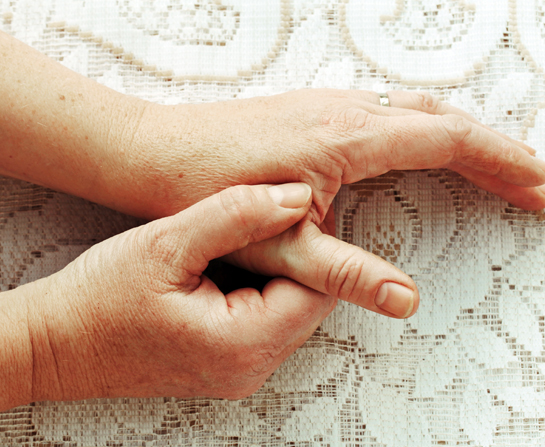Hope for the Skin & Joints : At War with the Joints
April 29, 2022 Return

Dr Raveendran Ramachandran Consultant Rheumatologist, Subang Jaya Medical Centre, Five facts about psoriatic arthritis
- Psoriatic arthritis, just like rheumatoid arthritis, can cause the joints to swell and become stiff. The tendons may also become inflamed. The affected areas are usually the spine, lower back, wrists, ankles, knees as well as the small joints of the hands and feet. As a result, movement becomes difficult and even painful.
- Unique to psoriatic arthritis is the swelling of the entire fingers and toes (dactilytis), which can cause great pain. This condition is not seen in people with rheumatoid arthritis.
- People with psoriatic arthritis may also experience constant fatigue. Other symptoms may include changes to the nails (becoming pitted or separated from the flesh), and redness and pain in the eyes (uveitis).
- There is no link between the severity of psoriasis and psoriatic arthritis. Both conditions can be of the same degree of severity, or one can be severe while the other is mild.
- If left untreated, this condition will lead to increasing damage to the joint tissues. Movement will become more painful and difficult, and permanent deformities at the joints can also occur.
Early diagnosis and treatment can make a big difference in preventing psoriatic arthritis from becoming more severe. In fact, there are studies which suggested that delaying treatment for six months can lead to irreversible joint deformities! Therefore, if you have psoriasis , tell your doctor if you experience any unusual aches and pains in your body.
Treating psoriatic arthritis
Methotrexate has been in use for a long time, and it is still an effective one for many people with psoriasis and/or psoriatic arthritis. It costs less than most of the new generation medications, so it is also a cost-effective treatment.
The newer generation medications, called biologics, target specific pathways involved in the inflammation process, so unlike conventional medications, they work in a more specific and often more effective manner. Commonly used biologics in Malaysia are:
- Tumor necrosis factor-alpha (TNF-alpha) blockers, such as etanercept and adalimumab. These medications block the actions of TNF-alpha, which are present in high levels in patients with psoriasis and/or psoriatic arthritis.
- Interleukin inhibitors. These medications target specific proteins called interleukins that are involved in the immune system reactions that lead to joint inflammation. Some examples are ustekinumab and secukinumab.
Secukinumab is a biologic that has just been recently launched in Malaysia. In addition to being able to help eight out of 10 patients achieve clear skin, it has been found to result in the following:
More than 80% patients showed 20% improvement (ACR response) from baseline after given secukinumab 150mg for 1 year.1
More than 80% of patients found that secukinumab managed to stop the progression of their joint damage.2
Just like with psoriasis, the best choice of medication(s) may differ from one person to another, depending on the severity of the condition and whether the person is responding adequately to the medication. If the patient is not responding well to a medication after a certain period of time, the rheumatologist will most likely prescribe another type of medication.
In addition to the above, the rheumatologist may also prescribe non-steroidal anti-inflammatory drugs (NSAIDs), such as aspirin and ibuprofen, to offer short-term relief for joint pain and stiffness.
Living with psoriatic arthritis
In addition to tending to their psoriasis, people with psoriatic arthritis also need to see to their joint and muscle health.
Stay active. Regular physical activity is important. This may seem like a contradictory notion, but in truth, regular physical activity actually helps to strengthen the joints and muscles, improve flexibility and help with better movement and boost your overall health.
Despite hampered movement caused by the condition, there are still physical activities that you can do. For example:
- Walking. You can use walking aids or shoe inserts to avoid placing too much stress on your knees, ankles or feet.
- Water-based activities such as swimming. The buoyancy of water can support your body and reduce the stress on the joints.
You can consult with your rheumatologist on your best options.
Eat healthily. To date, there is no special diet that has been proven to improve psoriatic arthritis. However, you should eat healthy, balanced meals, as they provide all the necessary nutrients needed to improve and maintain your health.
References:
van der Heijde, D., et. al. (2015). THU0414 Secukinumab Inhibits Radiographic Progression in Patients with Psoriatic Arthritis: Data from a Phase 3 Randomized, Multicenter, Double-Blind, Placebo-Controlled Study (Future 1). Ann Rheum Dis;74:347-348 doi:10.1136/annrheumdis-2015-eular.1806
Novartis International AG. (2015). Novartis reports landmark Phase III results for AIN457 (secukinumab) showing rapid and significant efficacy in psoriatic arthritis patients. Retrieved on July 19, 2016 from https://www.novartis.com/news/media-releases/novartis-reports-landmark-phase-iii-results-ain457-secukinumab-showing-rapid-and
[t1]Set Ley, this part is about people who have psoriasis but are not diagnosed with psoriatic arthritis yet. Dr Raveendran says that people with psoriatic arthritis sometimes come to see him when the disease has progressed, because they ignore signs such as unusual aches and pains. He wants people to see a doctor early. So we may confuse the reader about the message if we add “or psoriatic arthritis” here.
If you like this article, do subscribe here.
